Granular memory
 By carrying out numerical simulations, we have found that a random pack of soft grains can “remember” the waveform of shear strains applied while the system was compressed. When the system is later decompressed, the remembered waveform is recalled in time-reversed order as measurable shear stresses. It appears that the mechanism for the memory is friction between grain-grain contacts — according to Coulomb’s law such contacts can sustain a range of transverse forces and this can provide a way to store information. Preprint: https://arxiv.org/abs/2304.12981
By carrying out numerical simulations, we have found that a random pack of soft grains can “remember” the waveform of shear strains applied while the system was compressed. When the system is later decompressed, the remembered waveform is recalled in time-reversed order as measurable shear stresses. It appears that the mechanism for the memory is friction between grain-grain contacts — according to Coulomb’s law such contacts can sustain a range of transverse forces and this can provide a way to store information. Preprint: https://arxiv.org/abs/2304.12981
Quasi one-dimensional 3He
 (With Neil Sullivan’s group at the University of Florida) By confining 3He to the cylindrical nanotubes of MCM-41 and cooling this system to temperatures down to 10 mK, we have created an effectively one-dimensional Fermi liquid (a Luttinger liquid) that can be cooled deep into the degenerate regime. Using NMR relaxation times, we have explored the correlation functions for the motions of the 3He atoms, and compared our results to predictions from Luttinger-liquid theory. Ref: J. Adams, M. Lewkowitz, C. Huan, D. Candela, and N. S. Sullivan, Phys. Rev. B 106, 195402 (2022).
(With Neil Sullivan’s group at the University of Florida) By confining 3He to the cylindrical nanotubes of MCM-41 and cooling this system to temperatures down to 10 mK, we have created an effectively one-dimensional Fermi liquid (a Luttinger liquid) that can be cooled deep into the degenerate regime. Using NMR relaxation times, we have explored the correlation functions for the motions of the 3He atoms, and compared our results to predictions from Luttinger-liquid theory. Ref: J. Adams, M. Lewkowitz, C. Huan, D. Candela, and N. S. Sullivan, Phys. Rev. B 106, 195402 (2022).
Granular channel flow

 (With Kevin Facto) We have used MRI and PFGNMR to study the fluctuating motion of grains as they flow through a vertical channel driven by gravity.
(With Kevin Facto) We have used MRI and PFGNMR to study the fluctuating motion of grains as they flow through a vertical channel driven by gravity.
 Although the average flow is plug-like with apparent shear bands at the walls, our study shows that the flow is actually controlled by random, transient jamming events in which even grains in the center of the channel come momentarily to rest. The figure on the right shows data from an NMR experiment designed to image only those grains that are at rest during each repetition of the measurement. The figure on the bottom shows density-density correlations revealing an organized density wave in the flow at much higher flow rates.
Although the average flow is plug-like with apparent shear bands at the walls, our study shows that the flow is actually controlled by random, transient jamming events in which even grains in the center of the channel come momentarily to rest. The figure on the right shows data from an NMR experiment designed to image only those grains that are at rest during each repetition of the measurement. The figure on the bottom shows density-density correlations revealing an organized density wave in the flow at much higher flow rates.
Dilute 3He impurities in solid 4He
 (With Neil Sullivan’s group at the University of Florida) Solid 4He containing very dilute (ppm) 3He impurities exhibits interesting transitions in mechanical behavior at millikelvin temperatures, originally ascribed to supersolidity but now more commonly thought to be associated with binding of the impurities onto dislocation lines. We have measured the nuclear susceptibility and relaxation for the impurities, in experiments made challenging by the small impurity concentration and long T1 time. In addition to an expected transition at lower temperatures due to phase separation of the impurities, we see a sharp peak in T1 that can be fit to a model with activated motion at disparate time scales. Ref: C. Huan, S. S. Kim, D. Candela and N. S. Sullivan, J. Low Temp. Phys. 175, 133 (2013).
(With Neil Sullivan’s group at the University of Florida) Solid 4He containing very dilute (ppm) 3He impurities exhibits interesting transitions in mechanical behavior at millikelvin temperatures, originally ascribed to supersolidity but now more commonly thought to be associated with binding of the impurities onto dislocation lines. We have measured the nuclear susceptibility and relaxation for the impurities, in experiments made challenging by the small impurity concentration and long T1 time. In addition to an expected transition at lower temperatures due to phase separation of the impurities, we see a sharp peak in T1 that can be fit to a model with activated motion at disparate time scales. Ref: C. Huan, S. S. Kim, D. Candela and N. S. Sullivan, J. Low Temp. Phys. 175, 133 (2013).
Giant viscosity increase of a fully-polarized Fermi liquid
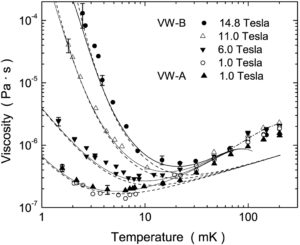 (With Hikota Akimoto and Neil Sullivan’s group at the University of Florida) A Fermi liquid in a sufficiently high magnetic field will be nearly 100% spin-polarized at temperatures well below the Fermi temperature, and due to the nearly complete suppression of scattering between opposite spins the momentum transport (viscosity) can be hugely enhanced. Using a novel large-surface-area vibrating wire viscometer, we have observed thousand-fold increases in the viscosity of a dilute 3He-4He liquid. These experiments were carried out at the NHMFL High B/T facility. Ref: H. Akimoto, J. S. Xia, D. Candela, W. J. Mullin, E. D. Adams, and N. S. Sullivan, Phys. Rev. Lett. 99, 095301 (2007).
(With Hikota Akimoto and Neil Sullivan’s group at the University of Florida) A Fermi liquid in a sufficiently high magnetic field will be nearly 100% spin-polarized at temperatures well below the Fermi temperature, and due to the nearly complete suppression of scattering between opposite spins the momentum transport (viscosity) can be hugely enhanced. Using a novel large-surface-area vibrating wire viscometer, we have observed thousand-fold increases in the viscosity of a dilute 3He-4He liquid. These experiments were carried out at the NHMFL High B/T facility. Ref: H. Akimoto, J. S. Xia, D. Candela, W. J. Mullin, E. D. Adams, and N. S. Sullivan, Phys. Rev. Lett. 99, 095301 (2007).
Gas-Fluidized granular bed
 (With Chao Huan and Ron Walsworth’s group at Harvard-Smithsonian) A granular bed fluidized by the upward flow of interstitial gas can exist in the curious and technologically important “bubbling” state, in which large gas bubbles rise through the bed despite the absence of surface tension to stabilize the bubble boundaries. We have used NMR to measure the increase in grain motion fluctuations passing from the non-bubbling (left) to bubbling (right) states. Our collaborators in the Walsworth group at HSCFA have used hyperpolarized xenon NMR to directly measure the gas motion in this system. Ref: T. Pavlin et al., Appl. Magn. Resonance 32, 93 (2007).
(With Chao Huan and Ron Walsworth’s group at Harvard-Smithsonian) A granular bed fluidized by the upward flow of interstitial gas can exist in the curious and technologically important “bubbling” state, in which large gas bubbles rise through the bed despite the absence of surface tension to stabilize the bubble boundaries. We have used NMR to measure the increase in grain motion fluctuations passing from the non-bubbling (left) to bubbling (right) states. Our collaborators in the Walsworth group at HSCFA have used hyperpolarized xenon NMR to directly measure the gas motion in this system. Ref: T. Pavlin et al., Appl. Magn. Resonance 32, 93 (2007).
Vibrofluidized granular gas
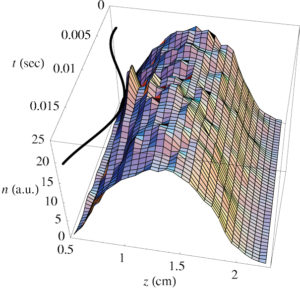
 (With Xiaoyu Yang and Chao Huan) A “granular gas” can be created by forcefully vibrating a container of grains at high frequency (50 Hz in our case). Using NMR we have measured the vertical profiles of the density (left and top right) and the granular temperature, that is the mean kinetic energy of the grains (bottom right). We find an excellent fit to the predictions of granular hydrodynamics (solid lines), which include an unusual effect: Granular heat can flow from cold to hot, which would violate the second law of thermodynamics for a system in equilibrium. This system is far from equilibrium, and manifests this effect by a minimum in the granular temperature (bottom right) despite the strictly upward flow of heat. Ref: C. Huan, X. Yang, D. Candela, and R. L. Walsworth, Phys. Rev. E 69, 041302 (2004).
(With Xiaoyu Yang and Chao Huan) A “granular gas” can be created by forcefully vibrating a container of grains at high frequency (50 Hz in our case). Using NMR we have measured the vertical profiles of the density (left and top right) and the granular temperature, that is the mean kinetic energy of the grains (bottom right). We find an excellent fit to the predictions of granular hydrodynamics (solid lines), which include an unusual effect: Granular heat can flow from cold to hot, which would violate the second law of thermodynamics for a system in equilibrium. This system is far from equilibrium, and manifests this effect by a minimum in the granular temperature (bottom right) despite the strictly upward flow of heat. Ref: C. Huan, X. Yang, D. Candela, and R. L. Walsworth, Phys. Rev. E 69, 041302 (2004).
Zero-temperature spin-wave damping at high B/T
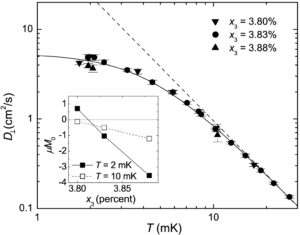 (With Hikota Akimoto and Neil Sullivan’s group at the University of Florida) The existence of polarization-induced damping of spin waves as T goes to zero has been controversial both theoretically and experimentally. By tuning the 3He concentration in a 3He-4He mixture through the concentration at which the spin-wave dispersion changes sign (approximated 3.8%), we obtained new, unambiguous evidence for this effect. Ref: H. Akimoto, D. Candela, J. S. Xia, W. J. Mullin, E. D. Adams, and N. S. Sullivan, Phys. Rev. Lett. 90, 105301 (2003).
(With Hikota Akimoto and Neil Sullivan’s group at the University of Florida) The existence of polarization-induced damping of spin waves as T goes to zero has been controversial both theoretically and experimentally. By tuning the 3He concentration in a 3He-4He mixture through the concentration at which the spin-wave dispersion changes sign (approximated 3.8%), we obtained new, unambiguous evidence for this effect. Ref: H. Akimoto, D. Candela, J. S. Xia, W. J. Mullin, E. D. Adams, and N. S. Sullivan, Phys. Rev. Lett. 90, 105301 (2003).
Two-phase flow in porous media
 (With Xiaoyu Yang and Takato Handa) When a nonwetting fluid (oil) is displaced from a porous medium by a wetting fluid (water), the oil-water front can be stable, unstable to fingering, or even fractal depending on the experimental parameters. We have used MRI with chemical-shift and relaxation-time contrast between the two fluids to visualize such displacement fronts.
(With Xiaoyu Yang and Takato Handa) When a nonwetting fluid (oil) is displaced from a porous medium by a wetting fluid (water), the oil-water front can be stable, unstable to fingering, or even fractal depending on the experimental parameters. We have used MRI with chemical-shift and relaxation-time contrast between the two fluids to visualize such displacement fronts.
Hydrodynamic dispersion in porous media
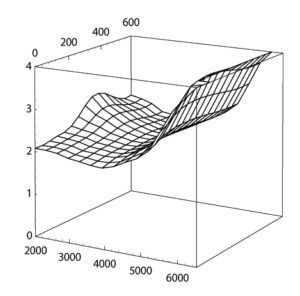 (With Aimin Ding) Taylor dispersion is the process in which fluid molecules in a channel or porous medium effectively diffuse much faster in the presence of a bulk fluid flow. More generally a nonlocal (frequency and wavenumber dependent) dispersion coefficient can be defined, which will have features reflecting the geometry of the medium through which the fluid flows. We have used PFGNMR to measure the nonlocal dispersion for water flowing through a pack of spherical beads. Ref: A. Ding and D. Candela, Phys. Rev. E 54, 656 (1996).
(With Aimin Ding) Taylor dispersion is the process in which fluid molecules in a channel or porous medium effectively diffuse much faster in the presence of a bulk fluid flow. More generally a nonlocal (frequency and wavenumber dependent) dispersion coefficient can be defined, which will have features reflecting the geometry of the medium through which the fluid flows. We have used PFGNMR to measure the nonlocal dispersion for water flowing through a pack of spherical beads. Ref: A. Ding and D. Candela, Phys. Rev. E 54, 656 (1996).
Nuclear magnetism of 3He in silica aerogel
(With Neal Kalechofsky) The physical and nuclear magnetic properties of helium are greatly affected by van der Waals forces near a solid surface, and silica aerogel has an enormous surface area per unit volume. We measured large changes in the nuclear magnetic susceptibility of and relaxation time of 3He filling aerogel when 4He was added to the system. This is explained by the preferential occupation of solid-like helium layers near the aerogel strands by 4He, due to its smaller zero-point motion. Ref: N. Kalechofsky and D. Candela, J. Low Temperature Phys. 101, 379 (1995).
Spin wave damping and field-dependent viscosity of 3He
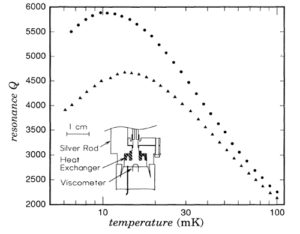 (With Lijuan Wei) By cooling 3He systems to temperatures below 10 mK in an 8 T magnetic field, two effects of spin polarization on transport in a Fermi liquid were observed: The anisotropy of spin diffusion, and a magnetic field dependent viscosity. The former was measured using spin echoes in a 3He-4He liquid, while the latter used a vibrating-wire viscometer (left). Refs: L-J. Wei, N. Kalechofsky, and D. Candela, Phys. Rev. Lett. 71, 879 (1993); D. Candela, L-J. Wei, D. R. McAllaster, and W. J. Mullin, Phys. Rev. Lett. 67, 330 (1991).
(With Lijuan Wei) By cooling 3He systems to temperatures below 10 mK in an 8 T magnetic field, two effects of spin polarization on transport in a Fermi liquid were observed: The anisotropy of spin diffusion, and a magnetic field dependent viscosity. The former was measured using spin echoes in a 3He-4He liquid, while the latter used a vibrating-wire viscometer (left). Refs: L-J. Wei, N. Kalechofsky, and D. Candela, Phys. Rev. Lett. 71, 879 (1993); D. Candela, L-J. Wei, D. R. McAllaster, and W. J. Mullin, Phys. Rev. Lett. 67, 330 (1991).
Nuclear spin waves in dilute 3He-4He mixtures
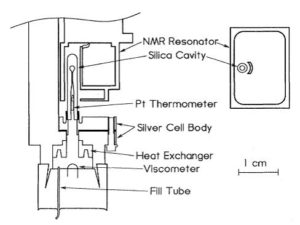 (
(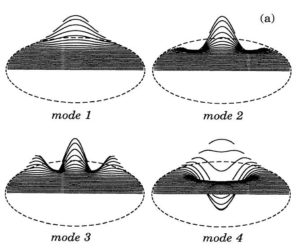 With Don McAllaster) We developed a new technique for measuring spin-wave dispersion and damping in a Fermi liquid by confining the liquid to a small spherical cavity, and used this technique to measure the properties of spin waves in 3He-4He mixtures in an 8 T field. These experiments resolved a large discrepancy between earlier spin-echo experiments and theoretical calculations. Ref: D. Candela, D. R. McAllaster, L-J. Wei, and G. A. Vermeulen, Phys. Rev. Lett. 65, 595 (1990).
With Don McAllaster) We developed a new technique for measuring spin-wave dispersion and damping in a Fermi liquid by confining the liquid to a small spherical cavity, and used this technique to measure the properties of spin waves in 3He-4He mixtures in an 8 T field. These experiments resolved a large discrepancy between earlier spin-echo experiments and theoretical calculations. Ref: D. Candela, D. R. McAllaster, L-J. Wei, and G. A. Vermeulen, Phys. Rev. Lett. 65, 595 (1990).